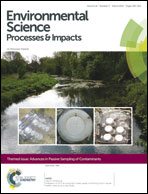Formation and release behavior of iron corrosion products under the influence of bacterial communities in a simulated water distribution system†
Abstract
To understand the formation and release behavior of iron corrosion products in a drinking water distribution system, annular reactors (ARs) were used to investigate the development processes of corrosion products and biofilm community as well as the concomitant iron release behavior. Results showed that the formation and transformation of corrosion products and bacterial community are closely related to each other. The presence of sulfate-reducing bacteria (SRB, e.g. Desulfovibrio and Desulfotomaculum), sulfur-oxidizing bacteria (SOB, e.g. Sulfuricella), and iron-oxidizing bacteria (IOB, e.g. Acidovorax, Gallionella, Leptothrix, and Sphaerotilus) in biofilms could speed up iron corrosion; however, iron-reducing bacteria (IRB, e.g. Bacillus, Clostridium, and Pseudomonas) could inhibit iron corrosion and iron release. Corrosion scales on iron coupons could develop into a two-layered structure (top layer and inner layer) with time. The relatively stable constituents such as goethite (α-FeOOH) and magnetite (Fe3O4) mainly existed in the top layers, while green rust (Fe6(OH)12CO3) mainly existed in the inner layers. The IOB (especially Acidovorax) contributed to the formation of α-FeOOH, while IRB and the anaerobic conditions could facilitate the formation of Fe3O4. Compared with the AR test without biofilms, the iron corrosion rate with biofilms was relatively higher (p < 0.05) during the whole experimental period, but the iron release with biofilms was obviously lower both at the initial stage and after 3 months. Biofilm and corrosion scale samples formed under different water supply conditions in an actual drinking water distribution system verified the relationships between the bacterial community and corrosion products.


 Please wait while we load your content...
Please wait while we load your content...